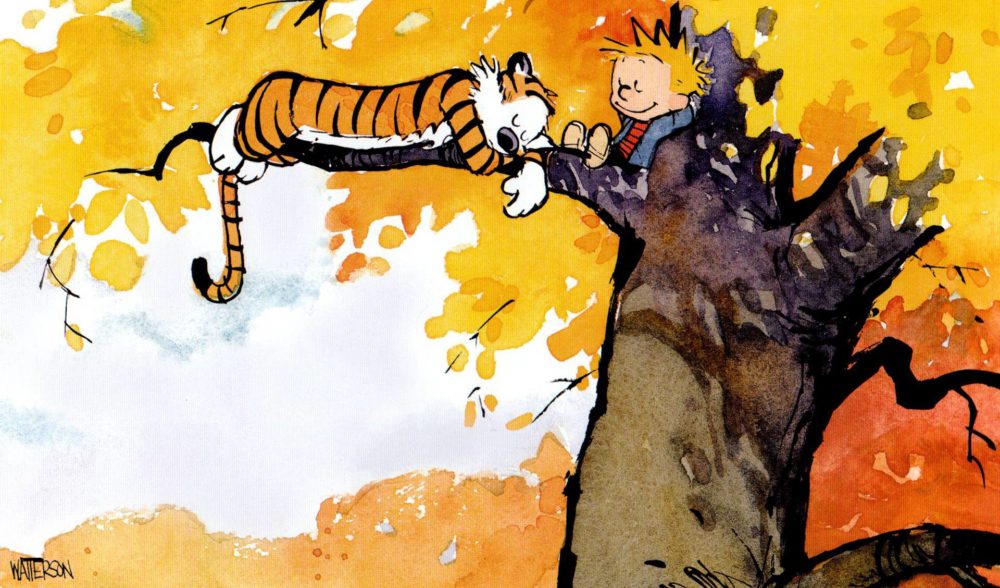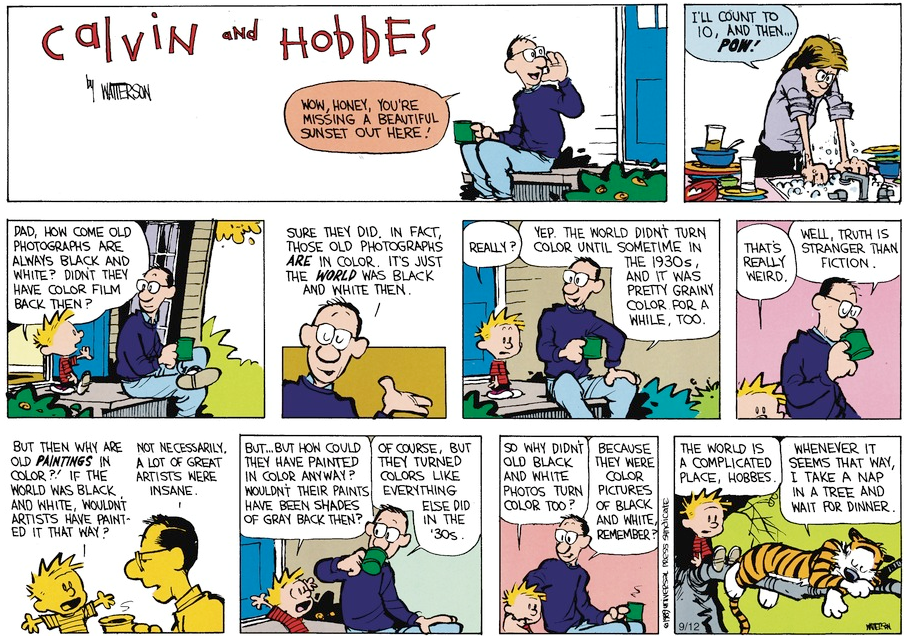Calvin and Hobbes is the stuff of legend. It’s widely viewed as one of the greatest comic strips of all time and the books (which are just collections of strips) have sold over 45 million copies. For comparison, the 58 Curious George books have sold 27 million copies in their history. In short, Calvin and Hobbes is beloved.
But does it hold up?
The strip was written between 1985 and 1995, at which point Bill Watterson decided he was done and would disappear from the public eye forever. It’s hard to blame him for not wanting to come back – he created an incredible shadow and it’s unlikely that anything equal or better could follow C&H.
Here is a link to a randomly chosen Sunday comic strip of Calvin & Hobbes. The original run date was September 12, 1989. Let’s dive in.
The top two frames were typically throwaway jokes, and this one isn’t bad. It was 1989, so perhaps this is kind of forward-thinking, showing that the husband is selfish or dopey for not helping the wife clean up after dinner. Interesting.
Calvin’s dad answering questions is the best. I’m not a parent, but this is something I think about when I think about parenting: When a kid asks me a question, do I make up the answer or do I give it to them honestly? Calvin’s dad was the king of making up the answers. He’s drawn so matter-of-factly that there’s not even a hint of hesitance in his mind that these things will be believed by Calvin and that the poor kid will figure out the truth on his own someday so they might as well have some fun now.
Calvin just asks such wonderfully innocent questions. It’s not just “How come old photos are black and white?” I remember another strip in which he asked about where the sun goes at night. Dad, if memory serves, said that it sets somewhere over Arizona.
This strip is more than just a simple question with a bullshit answer, though. It goes deeper. Calvin is smart. He doesn’t accept the first answer and walk away, which is true to his character. He digs deeper, forcing his dad to dig deeper and really drift into some parallel universe that probably provided the inspiration for the movie Pleasantville. Remember that scene when the town just magically starts to have color? That’s what Calvin’s dad is proposing here, nine years before the movie came out.
There’s more beauty to uncover there, though: Amid the ramblings of an insane man, Calvin’s dad is spitting truths that are so real (#tooreal) that they carry weight 27 years later. Yes, truth is stranger than fiction. We feel that every day lately. A lot of great artists were insane – some still are. Calvin’s last line plays into this painfully real revelation that yes, the world is a complicated place. Unimaginably so. Even if the things that Calvin’s dad said were all true, the world is still an impossibly complicated, intricately connected, indescribably complex thing.
The end result is something like an existential crisis for Calvin. He’s questioned everything he can come up with and there are no satisfactory answers. This is somewhere most humans have gone mentally at some point in their lives. He’s just having it happen around age five when the rest of us get it around…I don’t know, 20? 30? 50? Probably all of those.
Here’s where the strip gets me: What do you do when you’re overwhelmed by the world?
If you’re lucky, you go spend time with your best friend.
What a lovely message. There’s so much going on overall: The big questions, the playful lying to your kid, the kid who won’t take a bogus answer at face value, the curiosity of a really smart kid, the throwing your hands up in frustration (third-to-last panel), the blank stares of “I don’t understand this at all,” the trying to make sense of it with your best friend, and your best friend offering the sagest of wisdom.
Take a nap in a tree and wait for dinner. Sold.


